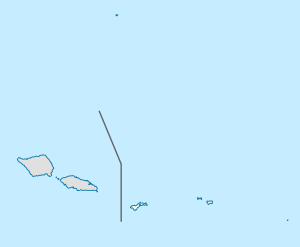Alofau
Alofau
Ālōfau | |
|---|---|
Village | |
| Coordinates: 14°16′45″S 170°36′8″W / 14.27917°S 170.60222°W / -14.27917; -170.60222 | |
| Country | |
| Territory | |
| County | Sa'Ole |
| Area | |
| • Total | 0.50 sq mi (1.29 km2) |
| Population (2010) | |
| • Total | 646 |
| • Density | 1,300/sq mi (500/km2) |
| Time zone | UTC−11 (Samoa Time Zone) |
| ZIP code | 96799 |
| Area code | +1 684 |
Alofau (Samoan: Ālōfau) is a village on the southeast coast of Tutuila Island, American Samoa. It is located at the eastern end of Faga'itua Bay, six miles east of Pago Pago, between Pagai and Amouli. It is home to Alofau Village Marine Protected Area. It is an agrarian and traditional village. It is also a poor village with residents with low literacy and high unemployment rates. As of the U.S. Census 2000, the per capita income was $4,357 and 67 percent of children were below the poverty line. 15.6 percent of residents were receiving public assistance.[1] It is lauded as a kava place in the Manu'a Songs.[2] Alofau is located in Sa'Ole County.[3][4]
Alofau Volcano is a major named volcano on Tutuila Island, although it is sometimes regarded as part of Pago Volcano.[5][6]
Great surfing conditions can be found in Faga'itua Bay near Alofau.[7]
An Adventist congregation had been established in the village by 1956.[8]
Geology
Alofau Volcano consists of thin-bedded aa and pāhoehoe flows, breccias, dikes, and tuffs exposed in a shield-shaped dome. The volcanic dome covers around 2,4 km2. on the east side of Faga'itua Bay. The volcano is built over a rift zone trending northeast–southwest. The lava flows are thinly bedded primitive olivine basalts, dipping 10-20 degrees away from Alofau village. A dike complex is exposed on the road southeast of Fagaitua village, while another 130 dikes are exposed in a promontory on the north side of Alofau. Large numbers of dikes are also seen south of Alofau village.[9]
Demographics
| Year | Population[10] |
|---|---|
| 2010 | 646 |
| 2000 | 495 |
| 1990 | 458 |
| 1980 | 418 |
| 1970 | 378 |
| 1960 | 316 |
| 1950 | 304 |
| 1940 | 134 |
| 1930 | 103 |
See also
- Alofau Village Marine Protected Area
References
- ^ Park, Clara C. and Russell Endo (2005). Asian and Pacific American Education: Learning, Socialization, and Identity. IAP. Pages 127-128. ISBN 9781607525080.
- ^ Krämer, Augustin (2000). The Samoa Islands: An Outline of a Monograph With Particular Consideration of German Samoa. University of Hawaii Press. Page 435. ISBN 9780824822194.
- ^ Tu’u’u, Misilugi Tulifau Tofaeono (2002). History of Samoa Islands: Supremacy & Legacy of the Malietoa (na Fa'alogo i Ai Samoa). Tuga'ula Publication. Page 427. ISBN 9780958219914.
- ^ Krämer, Augustin (2000). The Samoa Islands. University of Hawaii Press. Page 424. ISBN 9780824822194.
- ^ https://scholarspace.manoa.hawaii.edu/bitstream/10125/938/1/v39n4-311-320.pdf (Page 4).
- ^ Nunn, Patrick D. (1998). Pacific Island Landscapes. Page 165. ISBN 9789820201293.
- ^ Schyma, Rosemarie (2013). Südsee. DuMont Reiseverlag. Page 268. ISBN 9783770176946.
- ^ Watt, Abbie Le'ala Lam Yuen (2000). Tini: Trailblazer in the Wake of the Pitcairn. Teach Services, Inc. Page 53. ISBN 9781572581661.
- ^ Keating, Barbara H. and Barrie R. Bolton (2012). Geology and Offshore Mineral Resources of the Central Pacific Basin. Springer Science & Business Media. Page 152. ISBN 9781461228967.
- ^ "American Samoa Statistical Yearbook 2016" (PDF). American Samoa Department of Commerce. Archived from the original (PDF) on 2019-02-14. Retrieved 2019-07-25.
